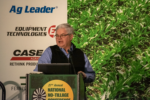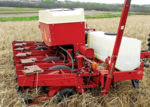Advertise Follow Us
Items Tagged with 'Corn yield'
ARTICLES
Longtime No-Tiller Experiments with Flown-on Cover Crops
Oats and radishes provide excellent results as no-tiller Randy DeSutter experiments with covers on 120 acres post-harvest corn and soybeans.
Read More
No-Till Farmer Influencers & Innovators
[Podcast] Growing Corn in 60-Inch Rows
In this episode of the “No-Till Farmer Influencers & Innovators” podcast, brought to you by Martin Industries, retired John Deere engineer Bob Recker shares an innovative idea for making better use of available sunlight that will allow you to protect your soils — and your no-till yields — when growing corn.
Read More
5 Top Notch Tips for Better No-Till Planting, Seed Placement
Striving for uniformity ‘every day of the year’ is the best approach to no-tilling crops and optimizing yields, says ag engineer Paul Jasa.
Read More
No-Till Out-Yields Tillage in Tough Conditions
Two long-term tillage studies in Indiana and Illinois prove no-till can yield as well as tillage and perform even better in periods of drought or heat stress.
Read More









